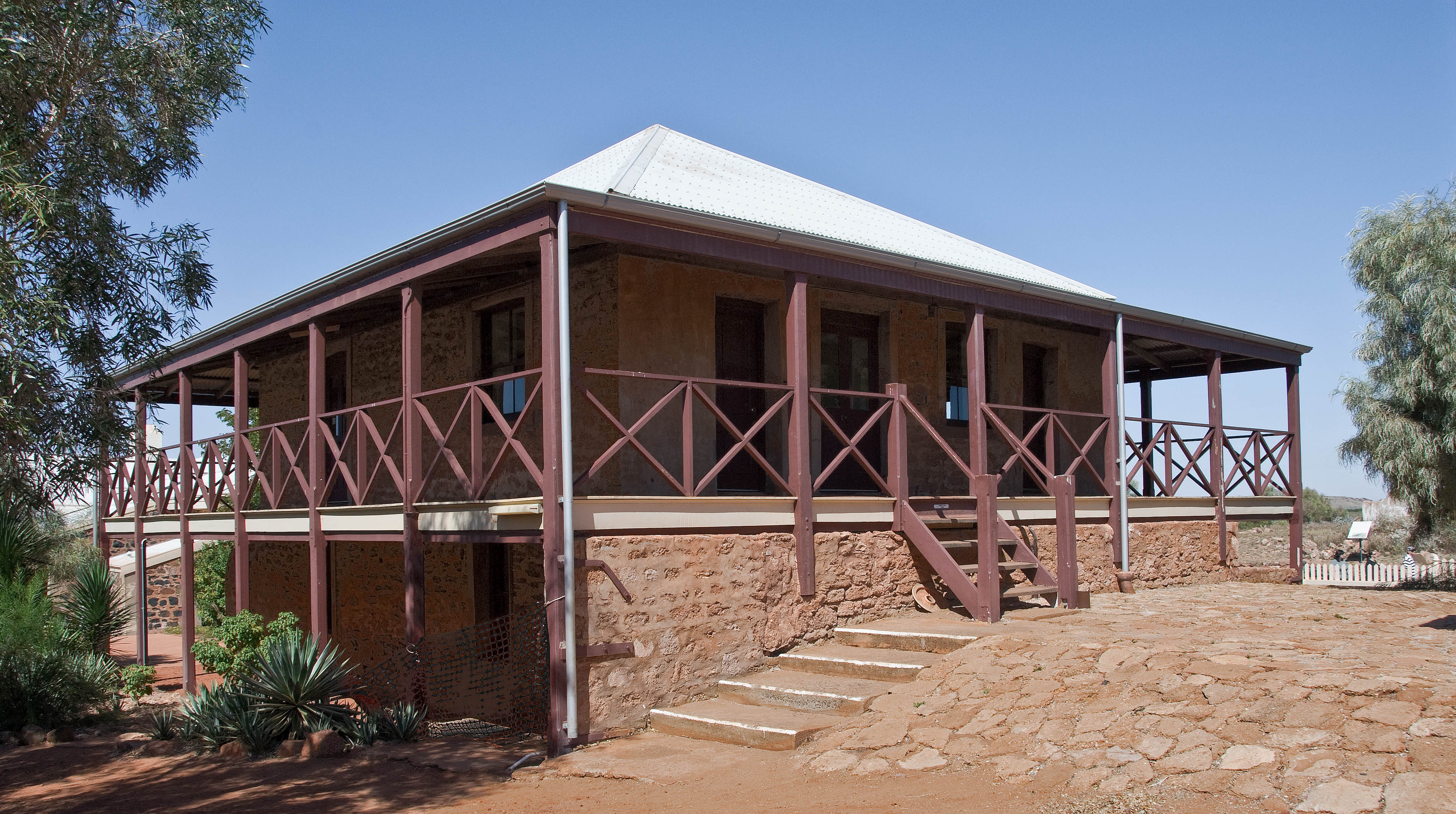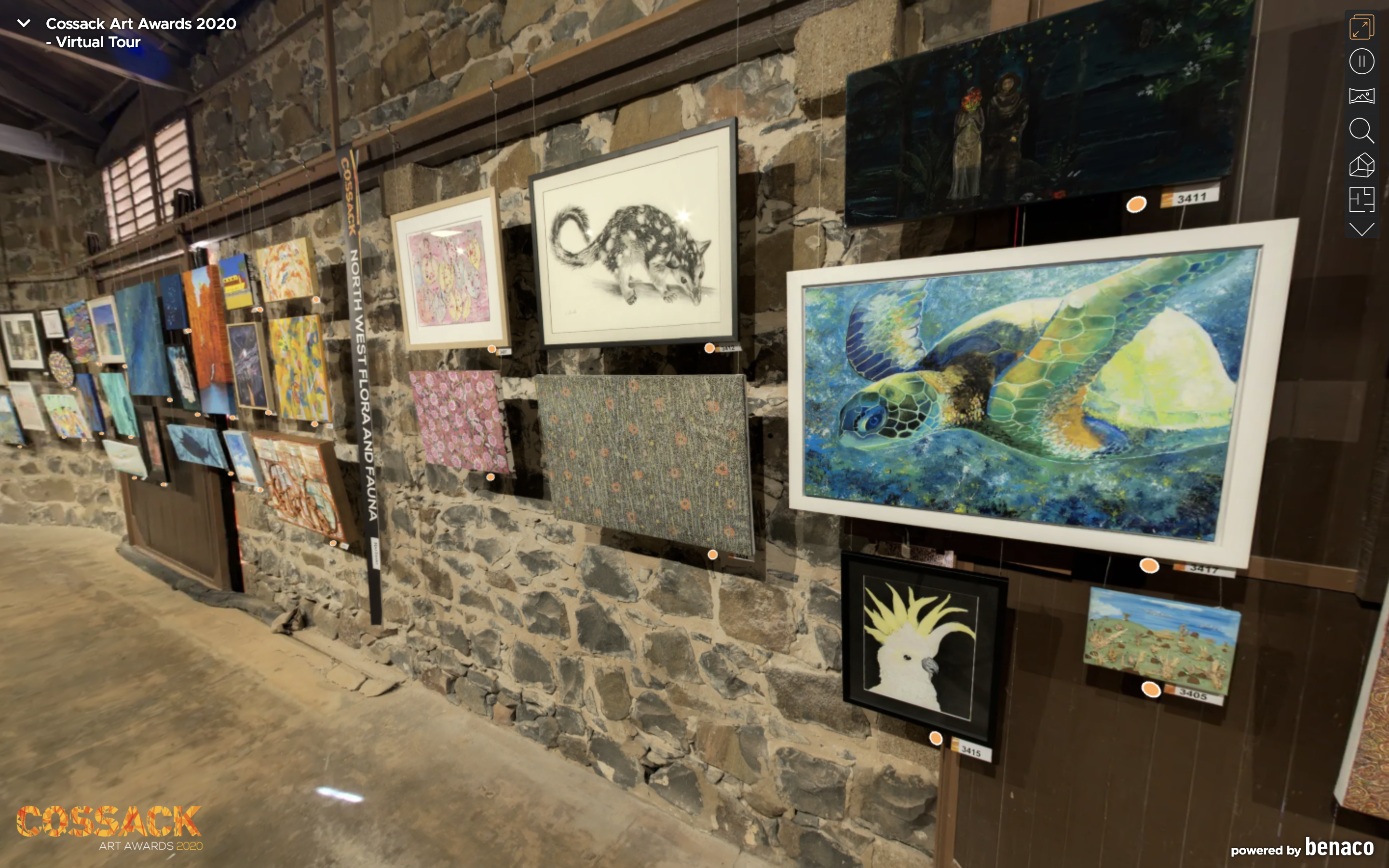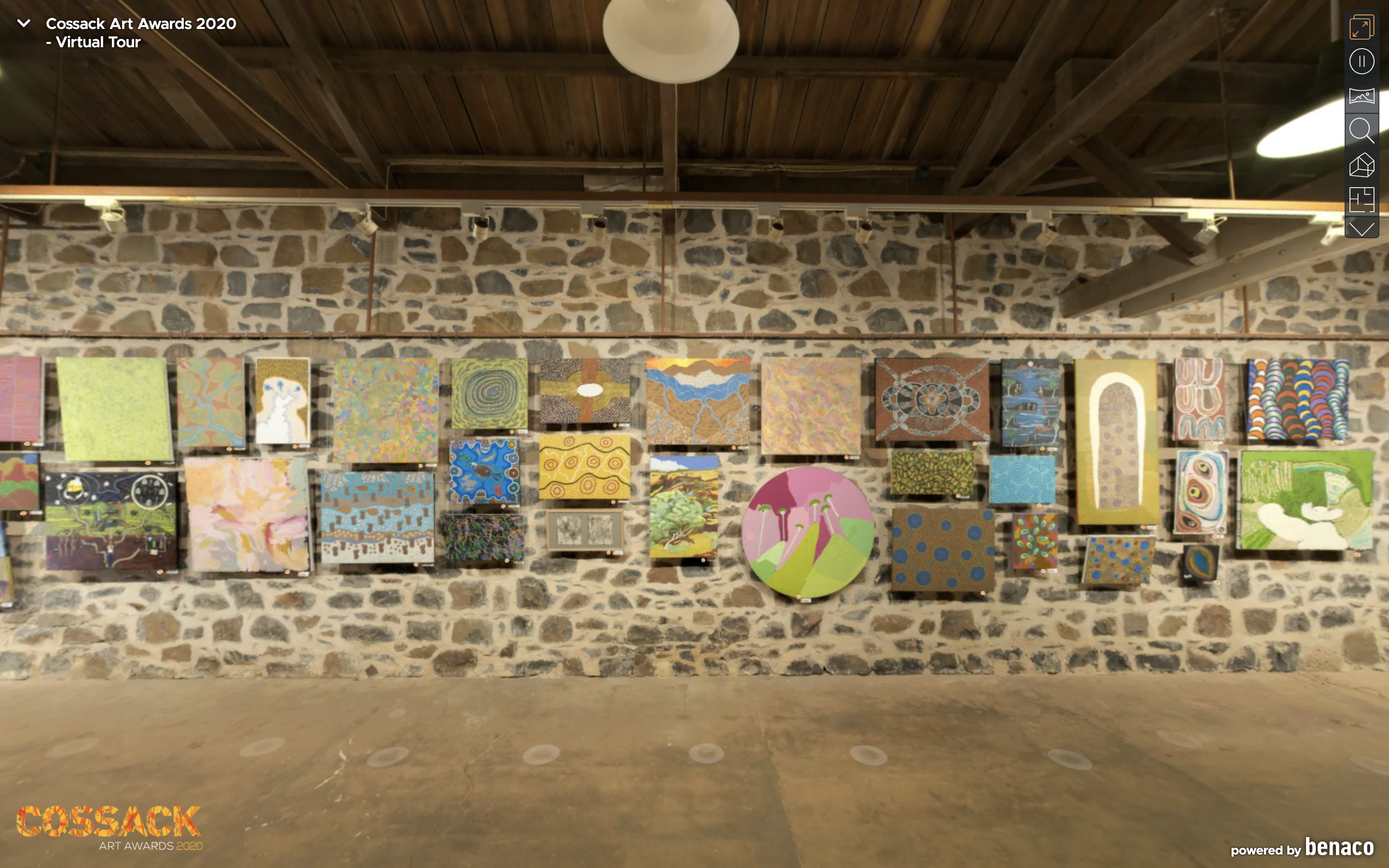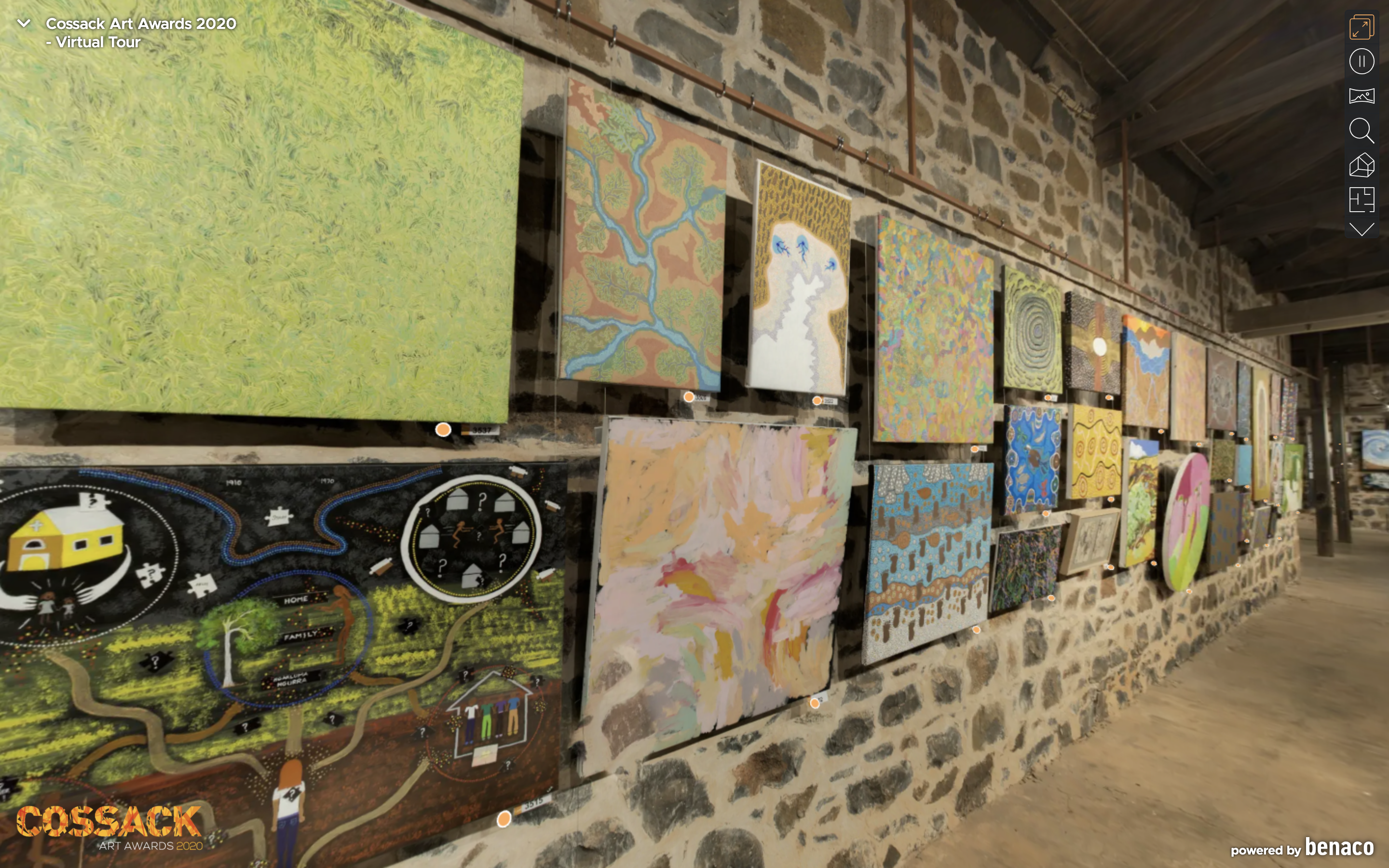Judging Cossack

16 September 2020
A dispatch from the Cossack Art Awards by Sharmila Wood
A traditional owner told me that she never visits Cossack at night because of ghosts and spirits. They sweep through the abandoned pearling town after dark and drown it in sorrow and despair. A search of the archive soon reveals accounts of Aboriginal men, women and children who were enslaved to work as pearl divers. This practice of ‘blackbirding’ is well documented and involved the capture of Aboriginal people for forced labor. In Tien Tsin Harbour, just near Cossack, this practice included Asian people, some of whom were also indentured from Malaysia, Indonesia, Singapore, Brunei and southern Thailand, but all known collectively as ‘Malays. Eighty luggers operated here at Cossack in the 1870s during a time where mother-of-pearl was considered fashionable as inlay in accessories, instruments, furniture and home-wares. By 1895 nearly 1000 Malays and 500 Aboriginal people were forced to work in the industry. However, it was not only work. There are records of Asian cultural celebrations including dragon parades; and rituals for mourning, such as the annual ceremony held at the Japanese cemetery where food and drink was left for the departed spirits and small boats laden with food were set adrift and floated out to sea. There are little offerings to the spirits reconcile their suffering, hardship and loss. Today, a group of heritage-listed stone buildings have stubbornly survived through devastating cyclones that regularly lash the northwest coastline.
This year I was invited to judge the Cossack Art Awards, an annual art event managed by the Town of Karratha, which usually has twelve acquisitive awards valued at over $100,000. The uncertainty around COVID-19 led to entries being restricted to artists from the Pilbara with six categories and only 150 paintings. The eccentric but democratic process allows artwork to be entered on a first come, first served basis. Often the Bond Store and its adjacent Telegraph and Post Building are hung floor to ceiling in a salon style presentation. Fewer entries allow for space around the works and make it a more pleasing experience than normal. This year, the Town of Karratha was able to commission a virtual experience featuring a 360-degree interaction with the artworks on display, and so the exhibition is accessible to anyone with a working internet connection.
Nicholas Werritt was the winner of this year’s Open Painting Theme with his landscape Horseshoe Gorge that invites the viewer to meander down the creek and explore the gorge captured in subtle shade of purple common to the Pilbara but often overlooked for more obvious reds and oranges; architect Jenni Hurley won the Portrait Prize with her whimsical and playful Pearl shell tiara that gestures to the still important pearling industry; while sixteen-year-old artist Simona Krstic won the Emerging Young Artist for Gag, which conveys ideas of repression, desperation and anxiety by hinting at unseen and terrifying things.
Art activity as a professional and commercial practice did not flourish in the Pilbara until the early 2000s but is now an intrinsic part of cultural life and contemporary culture, radiating from key Aboriginal art centres—Martumilli in Newman, Spinifex Hill Studios in Port Hedland, and an art cluster in Roebourne. There are a small number of artists working independently in the towns of Tom Price and Onslow, and, it is the region’s art centres that create the environment for arts practice to thrive. In the last twenty years, they have become and remain the nucleus for creative production. Whilst aesthetic distinctions across the Pilbara were on display, there are affinities between disparate groups because of themes, concerns and histories stemming from the experience of colonisation and the impact of industry on Country and culture.
When I first encountered the Pilbara, Gabrielle Sullivan was working with Martu artists and had ignited a potent energy that continues to emanate from the desert communities of Parnpajinya (Newman), Jigalong, Parnngurr, Punmu, Kunawarritji,and Irrungadji. Today, Martumili occupy an important place in the national Aboriginal art story and are housed in a large, architectural award winning art centre and gallery space which is a base for their services, spanning out across large swathes of the desert. In contrast, there has been consistent artistic activity in Roebourne for nearly two decades, and its artists still have no dedicated facility. Despite operating from cramped, uninsulated spaces and offices functioning as make-shift studios, artists and spaces such as Yinjaa Barni, Cheeditha Art Group, Juluwarlu and Roebourne Art Group have continued to support artists in their practice. In nearby Port Headland, the Spinifex Hill artists are a collective of Kariyarra, Banyjima, Nyiyparli, Yindjibarndi, Noongar, and Ngarla artists whose practice is informed by the culture of a large regional mining town where people live for work, family, education, health or as an impact of dispossession. The variety of people also reflects Port Hedland’s geographic location at the intersection of desert, central and coastal Pilbara communities and is a type of Indigenous cosmopolitanism that can be lost without grassroots knowledge. With this in mind, it might be unsurprising that artwork is highly individualised, which represents the mixed backgrounds of artists and ranges from representations of Country and Dreaming stories, and extends to quirky, humorous and playful scenes of daily life, reflections of inner worlds, and personal narratives.
That is all important backstory to the Cossack Art Awards, whose overall winner was Allery Sandy. She is one of Yinjaa Barni’s most senior artists, and her piece Marni is representative of her practice featuring methodical, and exquisitely detailed paintings with layers of alternating colour, lines, dots, and dashes, using sponge, brush, and skewer to create light, repeating patterns, and forms that dance across the canvas, swirling together into jeweled impressionistic tones. The work appears to slide interchangeably between the minutiae of landscape and the macro view of an aerial perspective, where form dissolves and colours blend. Allery Sandy’s stippled and intricate dots form gradations of colour that symbolise wildflowers blushing and moving across the landscape. The visual motif of seeds and bush plants provide many possibilities for Roebourne artists, who often depict various, seasonal times, bush medicine, and places connected to bush foods. Janice Sandy, the winner of the North West Flora and Fauna category is from the same school of painting as Allery, which is visible in the rhythmic movement created through detail and patterning.
The Martumili artist, Corban Clause Williams won Painting by a Pilbara Indigenous Artist for Kaalpa (Kalypa, Canning Stock Route Well 123). This is a tiny jewel of a painting that created a balance of compositional elements—his unusual colour choices could be discordant but there is a feeling of harmony to the overall composition. It is also highly original conveying his own interpretation and imagining of place. Kaalpa is a complex and evocative artwork that explores new realms of representation even as there are recognisable stylistic influences from the older generation of Martumili artists. Corban’s work is like a miniature of the epic collaborative paintings that map the spatial geography of special places and are a distinctive feature of Martumilli artists. These works are painted with the characteristic flare, visionary colour, and uninhibited expressive abstraction. This includes paintings such as Ngayarta Kujarra (Lake Dora, 2009), which was painted on Country by three generations of women. A large field of luminescent white dominates the canvas, emitting an aura of transcendence, which conveys the majestic mysticism of this place.
The ‘Painting by a Pilbara Indigenous Artist’ was a highly competitive category and demonstrated the importance of Aboriginal artists and their status as professional painters. The artist Gloria Kelly, who paints with Spinifex Hill Studio, created a highly original and unique work with an explosion of energetic brushstrokes. Kelly, who currently has an exhibition showing in Singapore has developed her own unique visual language and enjoys the movement of paint and creates in quick, energetic and loose brushstrokes. Doreen Chapman’s painting was another stand out work, which showed her typically enchanting depictions of desert life with a blend of figurative, abstract and naïve representation.
On the top floor of the Post and Telegraph building an intimate Mr Clifton Mack retrospective entitled Feels Right honoured the artist who began painting at Cossack with the Aboriginal art group Bujee Nhoor Pu and later joined Yinjaa Barni. The ten works on display include Jirda (Increase Site), which depicts a special ritual increase site for the regeneration of plants and is a painting that creates melodic, optical, movement. The painting, Jarmun Lighthouse, depicts the landmark lighthouse built in 1888, which is clearly visible from Cossack. The painting evokes the coastal identity of many people living in the Western Pilbara and I was told Mr Mack’s father worked on the island and in the lighthouse.
These works are documents of culture and heritage. Whilst there are many stories that remain untold, events such as the Cossack Art Awards provide an important platform for ensuring the visibility of artists, their work, and their place in the history of the Pilbara. They stand as a testament to the ongoing connection and celebration of life in a region that is unique, remarkable and welcoming when we know how to appreciate the aesthetic bounty that is on offer. With a history that includes trauma, the artists of the Pilbara offer healing through shared cultural events that paint the way forward itself.
This year I was invited to judge the Cossack Art Awards, an annual art event managed by the Town of Karratha, which usually has twelve acquisitive awards valued at over $100,000. The uncertainty around COVID-19 led to entries being restricted to artists from the Pilbara with six categories and only 150 paintings. The eccentric but democratic process allows artwork to be entered on a first come, first served basis. Often the Bond Store and its adjacent Telegraph and Post Building are hung floor to ceiling in a salon style presentation. Fewer entries allow for space around the works and make it a more pleasing experience than normal. This year, the Town of Karratha was able to commission a virtual experience featuring a 360-degree interaction with the artworks on display, and so the exhibition is accessible to anyone with a working internet connection.
Nicholas Werritt was the winner of this year’s Open Painting Theme with his landscape Horseshoe Gorge that invites the viewer to meander down the creek and explore the gorge captured in subtle shade of purple common to the Pilbara but often overlooked for more obvious reds and oranges; architect Jenni Hurley won the Portrait Prize with her whimsical and playful Pearl shell tiara that gestures to the still important pearling industry; while sixteen-year-old artist Simona Krstic won the Emerging Young Artist for Gag, which conveys ideas of repression, desperation and anxiety by hinting at unseen and terrifying things.
Art activity as a professional and commercial practice did not flourish in the Pilbara until the early 2000s but is now an intrinsic part of cultural life and contemporary culture, radiating from key Aboriginal art centres—Martumilli in Newman, Spinifex Hill Studios in Port Hedland, and an art cluster in Roebourne. There are a small number of artists working independently in the towns of Tom Price and Onslow, and, it is the region’s art centres that create the environment for arts practice to thrive. In the last twenty years, they have become and remain the nucleus for creative production. Whilst aesthetic distinctions across the Pilbara were on display, there are affinities between disparate groups because of themes, concerns and histories stemming from the experience of colonisation and the impact of industry on Country and culture.
When I first encountered the Pilbara, Gabrielle Sullivan was working with Martu artists and had ignited a potent energy that continues to emanate from the desert communities of Parnpajinya (Newman), Jigalong, Parnngurr, Punmu, Kunawarritji,and Irrungadji. Today, Martumili occupy an important place in the national Aboriginal art story and are housed in a large, architectural award winning art centre and gallery space which is a base for their services, spanning out across large swathes of the desert. In contrast, there has been consistent artistic activity in Roebourne for nearly two decades, and its artists still have no dedicated facility. Despite operating from cramped, uninsulated spaces and offices functioning as make-shift studios, artists and spaces such as Yinjaa Barni, Cheeditha Art Group, Juluwarlu and Roebourne Art Group have continued to support artists in their practice. In nearby Port Headland, the Spinifex Hill artists are a collective of Kariyarra, Banyjima, Nyiyparli, Yindjibarndi, Noongar, and Ngarla artists whose practice is informed by the culture of a large regional mining town where people live for work, family, education, health or as an impact of dispossession. The variety of people also reflects Port Hedland’s geographic location at the intersection of desert, central and coastal Pilbara communities and is a type of Indigenous cosmopolitanism that can be lost without grassroots knowledge. With this in mind, it might be unsurprising that artwork is highly individualised, which represents the mixed backgrounds of artists and ranges from representations of Country and Dreaming stories, and extends to quirky, humorous and playful scenes of daily life, reflections of inner worlds, and personal narratives.
That is all important backstory to the Cossack Art Awards, whose overall winner was Allery Sandy. She is one of Yinjaa Barni’s most senior artists, and her piece Marni is representative of her practice featuring methodical, and exquisitely detailed paintings with layers of alternating colour, lines, dots, and dashes, using sponge, brush, and skewer to create light, repeating patterns, and forms that dance across the canvas, swirling together into jeweled impressionistic tones. The work appears to slide interchangeably between the minutiae of landscape and the macro view of an aerial perspective, where form dissolves and colours blend. Allery Sandy’s stippled and intricate dots form gradations of colour that symbolise wildflowers blushing and moving across the landscape. The visual motif of seeds and bush plants provide many possibilities for Roebourne artists, who often depict various, seasonal times, bush medicine, and places connected to bush foods. Janice Sandy, the winner of the North West Flora and Fauna category is from the same school of painting as Allery, which is visible in the rhythmic movement created through detail and patterning.
The Martumili artist, Corban Clause Williams won Painting by a Pilbara Indigenous Artist for Kaalpa (Kalypa, Canning Stock Route Well 123). This is a tiny jewel of a painting that created a balance of compositional elements—his unusual colour choices could be discordant but there is a feeling of harmony to the overall composition. It is also highly original conveying his own interpretation and imagining of place. Kaalpa is a complex and evocative artwork that explores new realms of representation even as there are recognisable stylistic influences from the older generation of Martumili artists. Corban’s work is like a miniature of the epic collaborative paintings that map the spatial geography of special places and are a distinctive feature of Martumilli artists. These works are painted with the characteristic flare, visionary colour, and uninhibited expressive abstraction. This includes paintings such as Ngayarta Kujarra (Lake Dora, 2009), which was painted on Country by three generations of women. A large field of luminescent white dominates the canvas, emitting an aura of transcendence, which conveys the majestic mysticism of this place.
The ‘Painting by a Pilbara Indigenous Artist’ was a highly competitive category and demonstrated the importance of Aboriginal artists and their status as professional painters. The artist Gloria Kelly, who paints with Spinifex Hill Studio, created a highly original and unique work with an explosion of energetic brushstrokes. Kelly, who currently has an exhibition showing in Singapore has developed her own unique visual language and enjoys the movement of paint and creates in quick, energetic and loose brushstrokes. Doreen Chapman’s painting was another stand out work, which showed her typically enchanting depictions of desert life with a blend of figurative, abstract and naïve representation.
On the top floor of the Post and Telegraph building an intimate Mr Clifton Mack retrospective entitled Feels Right honoured the artist who began painting at Cossack with the Aboriginal art group Bujee Nhoor Pu and later joined Yinjaa Barni. The ten works on display include Jirda (Increase Site), which depicts a special ritual increase site for the regeneration of plants and is a painting that creates melodic, optical, movement. The painting, Jarmun Lighthouse, depicts the landmark lighthouse built in 1888, which is clearly visible from Cossack. The painting evokes the coastal identity of many people living in the Western Pilbara and I was told Mr Mack’s father worked on the island and in the lighthouse.
These works are documents of culture and heritage. Whilst there are many stories that remain untold, events such as the Cossack Art Awards provide an important platform for ensuring the visibility of artists, their work, and their place in the history of the Pilbara. They stand as a testament to the ongoing connection and celebration of life in a region that is unique, remarkable and welcoming when we know how to appreciate the aesthetic bounty that is on offer. With a history that includes trauma, the artists of the Pilbara offer healing through shared cultural events that paint the way forward itself.

^^^ Cossack Post & Telegraph Office (now the art gallery). Image sourced from Wikipedia.




^^^ Cossack Art Awards 2020 — Virtual tour. Screen grabs sourced August 2020.

^^^ Allery Sandy, Marni (2020). Cossack Art Awards.

^^^ Corban Clause Williams, Kaalpa (Kalypa, Canning Stock Route Well 123) (2020). Cossack Art Awards.

^^^ Clifton Mack, Jarman Island (Lighthouse). Yinjaa Barni Art.
